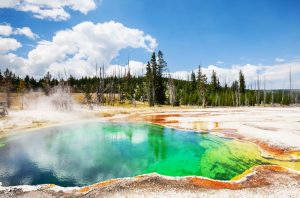A mathematical model and optical measurements are helping researchers explain the “stunning colors of Yellowstone National Park’s hot springs.” With the advent of this thermal imaging technology, researchers are able to visually recreate the way they believe these springs looked decades ago, long before the tourist traffic to the park has contaminated the springs with coins and other debris.
Scientists have long understood that the stunning displays at both Yellowstone and its Grand Prismatic Spring were a result of a “complicated interplay of underwater vents and bacteria.” Even though they knew how it worked, it was only recently that researchers were able to replicate the model with a series of mathematical equations that mimic the springs in their natural – non-human contaminated – states. The technology developed can replicate both the physical and chemical variables of the springs and transmit that info to a computer for viewing.

Yellowstone Park
Through the use of a simple, one-dimensional light model the researchers replicated the brilliant colors and characteristics of the hot springs and were able to account for the spectral reflections that emanate because of the microbials in the water including the scattering of the water droplets and the skylight that diffuses them.
Researchers were even able to put metrics in place to simulate the appearance of the pool for various periods throughout time, taking into consideration the significantly higher temperatures that existed in the 1880s and 1940s. They accounted for the fact that in some instances the vents in the springs have been partially covered up by human-introduced trash and coins (the metals impact the water’s inherent bacteria and change the color and patterns.)
The project was originally started as a way to study optical imaging and phenomena and evolved to include the climate changes and the optical changes in the springs over the decades.
UKA Optics manufactures lenses for diode laser collimators, CD and DVD players, laser pointers, laser levels, laser surface inspection systems and positioning and measuring equipment. Standard and custom laser lens assemblies.